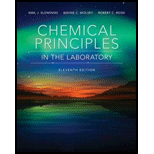
(a)
Interpretation: In the given system,
Concept introduction:
Calorimetry is a technique used to measure how much heat is produced or absorbed during a
Here,
(a)
Answer to Problem 1ASA
Explanation of Solution
The initial temperature is
Final temperature is
Expression for
Thus,
(b)
Interpretation: In the given system,
Concept introduction:
Calorimetry is a technique used to measure how much heat is produced or absorbed during a chemical reaction. It is used to determine the specific heat of the metal. The expression for heat evolved or absorbed is as follows:
Here,
(b)
Answer to Problem 1ASA
Explanation of Solution
The initial temperature of metal is
Final temperature is
Expression for
Thus,
(c)
Interpretation: The amount of heat flowed into the water is to be determined.
Concept introduction:
Calorimetry is a technique used to measure how much heat is produced or absorbed during a chemical reaction. It is used to determine the specific heat of the metal. The expression for heat evolved or absorbed is as follows:
Here,
(c)
Answer to Problem 1ASA
Explanation of Solution
Amount of water is
Specific heat of water is
Now, calculate heat flowing in water as follows:
Thus, heat flowed to water is
(d)
Interpretation: The specific heat of metal is to be determined.
Concept introduction:
Calorimetry is a technique used to measure how much heat is produced or absorbed during a chemical reaction. It is used to determine the specific heat of the metal. The expression for heat evolved or absorbed is as follows:
Here,
(d)
Answer to Problem 1ASA
Explanation of Solution
Amount of metal is
Heat given by metal is absorbed by water. Thus, heat given by metal is
Now, calculate heat flowing in water as follows:
Thus, the specific heat of metal is
(e)
Interpretation: The specific heat of metal is to be determined.
Concept introduction:
The relation between molecular mass and specific metal is as follows:
Here,
(e)
Answer to Problem 1ASA
Explanation of Solution
Substitute values in the above formula
Thus, the approximate molecular formula of metal is
Want to see more full solutions like this?
Chapter 14 Solutions
Chemical Principles in the Laboratory
 Chemistry for Engineering StudentsChemistryISBN:9781337398909Author:Lawrence S. Brown, Tom HolmePublisher:Cengage Learning
Chemistry for Engineering StudentsChemistryISBN:9781337398909Author:Lawrence S. Brown, Tom HolmePublisher:Cengage Learning Chemistry & Chemical ReactivityChemistryISBN:9781337399074Author:John C. Kotz, Paul M. Treichel, John Townsend, David TreichelPublisher:Cengage Learning
Chemistry & Chemical ReactivityChemistryISBN:9781337399074Author:John C. Kotz, Paul M. Treichel, John Townsend, David TreichelPublisher:Cengage Learning Chemistry & Chemical ReactivityChemistryISBN:9781133949640Author:John C. Kotz, Paul M. Treichel, John Townsend, David TreichelPublisher:Cengage Learning
Chemistry & Chemical ReactivityChemistryISBN:9781133949640Author:John C. Kotz, Paul M. Treichel, John Townsend, David TreichelPublisher:Cengage Learning General Chemistry - Standalone book (MindTap Cour...ChemistryISBN:9781305580343Author:Steven D. Gammon, Ebbing, Darrell Ebbing, Steven D., Darrell; Gammon, Darrell Ebbing; Steven D. Gammon, Darrell D.; Gammon, Ebbing; Steven D. Gammon; DarrellPublisher:Cengage Learning
General Chemistry - Standalone book (MindTap Cour...ChemistryISBN:9781305580343Author:Steven D. Gammon, Ebbing, Darrell Ebbing, Steven D., Darrell; Gammon, Darrell Ebbing; Steven D. Gammon, Darrell D.; Gammon, Ebbing; Steven D. Gammon; DarrellPublisher:Cengage Learning ChemistryChemistryISBN:9781305957404Author:Steven S. Zumdahl, Susan A. Zumdahl, Donald J. DeCostePublisher:Cengage Learning
ChemistryChemistryISBN:9781305957404Author:Steven S. Zumdahl, Susan A. Zumdahl, Donald J. DeCostePublisher:Cengage Learning Chemistry: An Atoms First ApproachChemistryISBN:9781305079243Author:Steven S. Zumdahl, Susan A. ZumdahlPublisher:Cengage Learning
Chemistry: An Atoms First ApproachChemistryISBN:9781305079243Author:Steven S. Zumdahl, Susan A. ZumdahlPublisher:Cengage Learning





